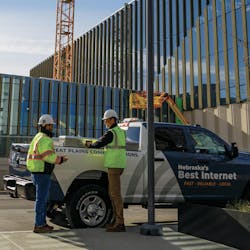A successful fiber network isn’t just about coverage—it’s about strategy, scalability and sustained performance.
The telecommunications industry has seen a variety of historical trends, whether it was the dot-com boom, the rush to near-net buildings, or today’s intense focus on fiber-to-the-home (FTTH) passings. History shows that without an effective ROI strategy, these trends can create long-term challenges.
For fiber providers serving a broad mix of customers and communities, network design must go beyond coverage. It should be purpose-built to address a range of needs, from residential and business connectivity to high capacity demands from hyperscalers and towers. That requires engineering routes with the foresight to enable scalability, ensure sustainability and maximize ROI on every mile of deployed fiber. Strategic planning and sufficient capacity are essential to support future growth and evolving community needs.
After more than 25 years in telecom and technology, I’d like to share some of my observations on trends I see shaping our industry for the future and some key strategic moves I strongly recommend considering today. If there’s one thing I’ve learned, it’s that a strategic, synchronized approach to fiber construction and customer acquisition is critical.
To be successful in the future, a provider must continually monitor market trends and look at each upcoming project strategically.
Construction Strategy, Service Delivery and Future Needs
Technologies like GPON, Ethernet, dark fiber and wavelength services offer flexibility, but strategic planning is what drives strong returns on capital. For providers serving a mix of customer types, each fiber build should be approached through a multi-segment lens: Can this route support residential homes and apartments? Are we capturing anchor institutions like hospitals, schools or government buildings along the way? Is there an opportunity to connect a small business with GPON and a regional bank or manufacturer with Ethernet?
Capacity planning must also look beyond today’s demand. Every build should be treated as a long-term investment, guided by questions such as: What’s likely to change in the near and distant future? What’s the next opportunity? What will customers need tomorrow that they may not need today? This forward-looking mindset is key to building networks that deliver value well into the future.
Here are a few considerations and recommendations to maximize revenue:
Misconceptions and Customer Expectations
One of the biggest misconceptions I see in our industry is the idea that being first to fiber guarantees long-term success. While that can be true in some cases, it is not a given. Incumbents can and do protect their base more aggressively than expected, forcing newer entrants to fight harder for market share. If you haven’t built in the ability to pivot or densify, ROI and take rates can suffer.
I once worked for a CEO who said that the most impactful thing we could do for every stakeholder, including communities, customers, employees, regulators and shareholders, was to run a financially sound business that truly prioritized the customer’s success.
Customers want solutions that help them best live their connected daily lives, with minimal obstructions. They want low latency and a reliable, secure connection for themselves, their employees and their customers. They want easy access to solutions like managed Wi-Fi for residents and businesses, managed firewall protection against evolving cyber threats, and unified communications—all services that enhance their connected lives. And when those services come from one local provider embedded in the community with firsthand knowledge of the community needs and culture, the customer success and overall experience are that much stronger.
At Great Plains Communications (GPC), we’ve leaned into densification in markets like Omaha, Nebraska. We didn’t try to go wide first; we went deep. Starting with commercial customers, we gradually built a residential presence, creating market diversity that delivers more stable, predictable returns. It’s a strategy that strengthens customer experience and financial performance alike.
Every build should be treated as a long-term investment, guided by questions such as: What’s likely to change in the near and distant future? What’s the next opportunity? What will customers need tomorrow that they may not need today?
Hyperscalers, Data Centers and the Digital Divide
Connecting metro markets via middle-mile fiber has long been considered a top priority. However, with the increasing use of AI, cloud computing and sophisticated enterprise networks, the landscape has changed significantly. Data centers and hyperscalers, such as Amazon Web Services (AWS), Google Cloud Platform (GCP) and Microsoft Azure, are becoming critical components of our connectivity system. For AI applications to process massive amounts of data in real-time, strong infrastructure with flexible architecture and technologies that provide low latency and increase network capabilities and resiliencies to support the bandwidth required to operate these data centers are essential. Continuous advancements in network technology and infrastructure to keep pace with AI’s rapid development should be on the to-do list for providers everywhere.
The current goal is to bring fiber-driven services, including high-speed internet, to communities everywhere (frequently referred to as “closing the digital divide”). To be successful in the future, a provider must continually monitor market trends and look at each upcoming project strategically when entering to serve the entire community. Are there potentially multiple customers and revenue opportunities across different lines of business? Is current capital sufficient for success, or will a project justify government funding? Can a provider pivot and execute successfully if an opportunity arises?
Market Analysis and Boots on the Ground—A Winning Combination
Market analysis plays a vital role—but like most things, it’s both an art and a science. Earlier in my career, I worked for one of the original CLECs. I moved from a well-established Manhattan market to help launch a new market in New Jersey. When we got the route maps from the network design team, they were based on wholesale demand sets. It looked good on paper—until we realized the fiber was passing dozens of AT&T office buildings because one customer dominated the data. We hadn’t fully accounted for concentration risk.
That experience taught me that data is critical, but it can’t be the only lens. Boots on the ground matter. Local insight, strong community relationships and an ongoing commitment to being part of the market’s fabric are essential. It’s not enough to build fiber and move on. Providers need to be trusted technology partners, in it for the long haul, committed to helping communities grow and thrive with next-generation connectivity.
Fiber has incredible power to transform economies and lives, but only when deployed strategically, thoughtfully and sustainably. Providers who approach fiber with a mindset of maximizing ROI, enabling customer success and planning for the future will be the ones who drive real progress and reap the rewards.
About the Author

Chris Sikora
Chief Revenue Officer, Great Plains Communications (GPC)
Chris Sikora is the Chief Revenue Officer for Great Plains Communications (GPC). He is responsible for driving new revenue across enterprise, residential, multi-dwelling unit (MDU), wholesale and channel business sectors. He is also responsible for continuing to elevate the GPC customer experience across all divisions and for leading and developing the sales and marketing teams.
Chris has over 25 years of experience developing technology solutions over fiber optic networks, launching and growing new platforms and building sustainable business models. His experience includes executive leadership roles at CenturyLink and Level 3 Communications (today rebranded as Lumen Technologies); Con Edison Communications; TW Telecom; and MFS Communications.
He has an MBA from New York University’s Stern School of Business and a Bachelor of Science from King’s College in Wilkes-Barre, Pennsylvania.
For more information, visit gpcom.com. Follow Chris on LinkedIn. Follow GPC on LinkedIn and Facebook.
